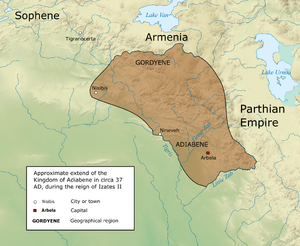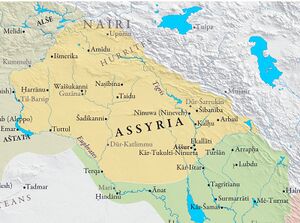Adiabene
| Author: Laxman Burdak, IFS (R) |



Adiabene was an ancient kingdom in northern Mesopotamia, corresponding to the northwestern part of ancient Assyria.[1] Arbela served as the capital of Adiabene.[2]
Variants
History
The size of the kingdom varied over time; initially encompassing an area between the Zab Rivers, it eventually gained control of Nineveh, and starting at least with the rule of Monobazos I (late 1st-century BC), Gordyene became an Adiabenian dependency. [3] It reached its zenith under Izates II, who was granted the district of Nisibis by the Parthian king Artabanus II (r. 12–40) as a reward for helping him regain his throne.[4] Adiabene's eastern borders stopped at the Zagros Mountains, adjacent to the region of Media.[5]Arbela served as the capital of Adiabene.[6]
The formation of the kingdom is obscure. The first instance of a recorded Adiabenian ruler is in 69 BC, when an unnamed king of Adiabene participated in the battle of Tigranocerta as an ally of the Armenian king Tigranes the Great (r. 95–55 BC).[7] However, coinage implies the establishment of a kingdom in Adiabene around 164 BC, following the disintegration of Greek Seleucid rule in the Near East.[8] Adiabene was conquered by the Parthian king Mithridates I (r. 171–132 BC) in ca. 145–141 BC, and by at least from the reign of Mithridates II (r. 124–91 BC) served as an integral part of the Parthian realm.[9]
Etymology
The name of the state entered English from the Ancient Greek Ἀδιαβηνή, which was derived from ܚܕܝܐܒ, Ḥaḏy’aḇ or Ḥḏay’aḇ, in Syriac. The state was also known as Nōdšīragān or Nōd-Ardaxšīragān in Middle Persian,[10]Նոր Շիրական, Nor Shirakan, in Armenian, and חַדְיָב, Ḥadyāḇ, in Hebrew.
Location
Adiabene occupied a district in Median Empire between the Upper Zab (Lycus) and the Lower Zab (Caprus), though Ammianus speaks of Nineveh, Ecbatana, and Gaugamela as also belonging to it.[11] By the late 1st century CE, its borders extended as far as Nisibis.
Nisibis was not part of Adiabene before 36, when Artabanus presented the city to Izates as a reward for his loyalty. Strabo[12] implies that Nisibis was not part of Adiabene, while Pliny[13] reports that Nisibis and Alexandria were chief cities of Adiabene. [14]
In the Talmudic writings the name occurs as חדייב ,חדייף and הדייב. Its chief city was Arbela (Arba-ilu), where Mar Uqba had a school, or the neighboring Hazzah, by which name the later Arabs also called Arbela.[15]
In Kiddushin 72a the Biblical Habor is identified with Adiabene,[16] but in Yerushalmi Megillah i. 71b with Riphath.[17] In the Targum to Jeremiah li. 27, Ararat, Minni, and Ashkenaz are paraphrased by Kordu, Harmini, and Hadayab, i.e., Corduene, Armenia, and Adiabene; while in Ezekiel xxvii. 23 Harran, Caneh, and Eden are interpreted by the Aramaic translator as "Harwan, Nisibis, and Adiabene."
Mention by Pliny
Pliny[18] mentions Adiabene.... The kingdom of the Persians, by which we now understand that of Parthia, is elevated upon the Caucasian chain between two seas, the Persian and the Hyrcanian. To the Greater Armenia, which in the front slopes towards Commagene, is joined Sophene, which lies upon the descent1 on both sides thereof, and next to it is Adiabene, the most advanced frontier of Assyria; a part of which is Arbelitis,2 He alludes to the town of Arbela, where, as it is generally said, the army of Darius was defeated by Alexander the Great; by which engagement the conflict was terminated. It was the fact, however, that Darius left his baggage and treasures at Arbela, while the battle really took place near the village of Gaugamela, about twenty miles to the north-west of Arbela. This place still retains its name of Arbil, where Alexander conquered Darius, and which joins up to Syria. The whole of this country was called Mygdonia by the Macedonians, on account of the resemblance it bore to Mygdonia3 in Europe. Its cities are Alexandria,4 and Antiochia, also called Nisibis5; this last place is distant from Artaxata seven hundred and fifty miles. There was also in former times Ninus6, a most renowned city, on the banks of the Tigris, with an aspect towards the west. Adjoining the other front of Greater Armenia, which runs down towards the Caspian Sea, we find Atropatene7, which is separated from Otene, a region of Armenia, by the river Araxes; Gazæ8 is its chief city, distant from Artaxata four hundred and fifty miles, and the same from Ecbatana in Media, to which country Atropatene belongs.
1 35 See c. 10.
2 He alludes to the town of Arbela, where, as it is generally said, the army of Darius was defeated by Alexander the Great; by which engagement the conflict was terminated. It was the fact, however, that Darius left his baggage and treasures at Arbela, while the battle really took place near the village of Gaugamela, about twenty miles to the north-west of Arbela. This place still retains its name of Arbil.
3 A district in the east of Macedonia, bordering on the Thermaic gulf and the Chalcidic peninsula.
4 Nothing is known of this place. Hardouin suggests that it may have been built on the spot where Alexander defeated Darius.
5 Also known as Antiochia Mygdoniæ, the capital of Mygdonia. Its ruins are still to be seen near a place called Nisibin. It stood on the river Mygdonius, now the Nahral Huali.
6 Or Nineveh, the capital of the great Assyrian monarchy, destroyed by the Medes and Babylonians about B.C. 606.
7 There is great difficulty in ascertaining, from the accounts given by the ancient writers, the exact limits of this district, but it is supposed to have included a considerable portion of the province now known by the name of Azerbaijan. It derived its name from Atropates or Atropes, who was governor of this district under the last Darius.
8 Most probably the place now known as Gazæa, the royal residence of the Parthian kings, and, as its name would imply, their treasure city. Colonel Rawlinson thinks that this place underwent many changes of name according to the rulers who successively occupied it; among other names, it appears to have borne that of Ecbatana.
References
- ↑ Kia, Mehrdad (2016). The Persian Empire: A Historical Encyclopedia. ABC-CLIO. ISBN 978-1610693912. (2 volumes), p. 54.
- ↑ Marciak 2017, p. 269.
- ↑ Marciak, Michał (2017). Sophene, Gordyene, and Adiabene: Three Regna Minora of Northern Mesopotamia Between East and West. BRILL. ISBN 9789004350724. pp. 269–270, 447.
- ↑ Frye, Richard Nelson (1984). The History of Ancient Iran. C.H.Beck. pp. 1–411. ISBN 9783406093975. "false." p. 279.
- ↑ Marciak 2017, p. 270.
- ↑ Marciak 2017, p. 269.
- ↑ Marciak 2017, p. 345.
- ↑ Marciak 2017, pp. 347, 422.
- ↑ Marciak, Michał; Wójcikowski, R. (2016). "Images of Kings of Adiabene: Numismatic and Scultpural Evidence". Iraq. Cambridge University Press. IX: 79–101. doi:10.1017/irq.2016.8. p. 347.
- ↑ Frye, Richard Nelson (1984). The History of Ancient Iran. C.H.Beck. ISBN 9783406093975. "false." p. 222.
- ↑ "Hist." xviii., vii. 1
- ↑ Geogr. xvi, 1, 1
- ↑ Hist. Nat. vi, 16, 42
- ↑ On the remnants of the ten tribes in the Khabur area, see Emil Schiirer, The Jewish People in the Time of Jesus Christ, II, ii, pp. 223-25; Avraham Ben-Yaakov, Jewish Communities of Kurdistan, [in Hebrew] (Jerusalem, 1961), pp. 9-11; Neusner, Jacob (1964). "The Conversion of Adiabene to Judaism: A New Perspective". Journal of Biblical Literature. 83 (1): 60–66. doi:10.2307/3264908. JSTOR 3264908.
- ↑ Yaqut, Geographisches Wörterbuch, ii. 263; Payne-Smith, Thesaurus Syriacus, under "Hadyab"; Hoffmann, Auszüge aus Syrischen Akten, pp. 241, 243.
- ↑ Compare Yebamot 16b et seq., Yalqut Daniel 1064
- ↑ enesis x. 3; compare also Genesis Rabba xxxvii.
- ↑ Natural History by Pliny Book VI/Chapter 16

